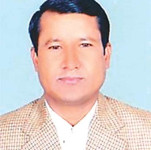
We use Google Cloud Translation Services. Google requires we provide the following disclaimer relating to use of this service:
This service may contain translations powered by Google. Google disclaims all warranties related to the translations, expressed or implied, including any warranties of accuracy, reliability, and any implied warranties of merchantability, fitness for a particular purpose, and noninfringement.

Highlights
- None of the powers in the country, including the state power, political parties, and the bureaucracy in the form of a permanent government, seem sensitive and serious to solve the Dalit problem in a proper manner.



The Dalit movement in Nepal was initially a social movement. The Dalit movement started in the year 2003 under the leadership of Bhagat Sarvajit Vishwakarma of Baglung had to spend a long time struggling against untouchability and caste discrimination.

The Nepali Dalit movement has reached its present state after going through many stages of ups and downs and struggles against the extremely inhumane exploitation and oppression of Dalits in the name of tradition, religion, culture and culture imposed by the feudal government. With the sacrifices, investments and contributions made by many of our historical and promising elders, nothing has been achieved in the central politics and Dalit movement. Similarly, it is sometimes heard that the Dalit movement should be conducted purely as a Dalitist.
Under the fundamental rights of the constitution created by the sovereign Constituent Assembly of the people, many rights related to Dalits including the right to live with dignity in Article 16, the right to equality in Article 18, the right against untouchability and discrimination in Article 24, and the provision of Dalit rights in Article 40 have been established.
Constitutionally and legally, the important agenda that the Nepali Dalit movement has been continuously raising for seven decades has been addressed to a certain extent, while some important questions are yet to be addressed. The Dalit agitation for the practical implementation of the achievements and the rights that have yet to be achieved continues. How will the state power advance the Dalit issue, which is a specific problem in South Asia? How will the political parties take it and why are they not serious about this issue? Political Dalit fraternal organizations, civil society, intellectuals, etc., who stand in favor of Dalit rights, what kind of course of action should they adopt? There is a need for serious discussion and debate on all these issues.
Right now, Dalit rights activist Khagendra Sunar is holding a sit-in in the country's capital with his body wrapped in chains saying, "Is it right for Dalits?" The government should immediately fulfill their legitimate demand that the state should grant rights to the Dalit community and allow them to participate in the state bodies. It is necessary to discuss his argument that Dalit movement can rise above the political movement and solve the problem of oppression of Dalits only by being completely Dalitist.
There is a need for a broad debate within the Dalit movement about the content of the Dalit movement, the interrelationship of Dalit oppression with the state power, the necessary structure, ideological and theoretical aspects, willpower etc. in the state power for the effective implementation of constitutional and legal provisions related to Dalits. Similarly, since the oppression of the Dalit community is interrelated with the base and infrastructure of the entire state power, there should be more debate about the future direction of the Dalit movement.
The ideology of the Dalit movement
Any movement in the world is based on a political philosophy. Political philosophy is essential to understand life and the world, every object, event or problem. The study of overall aspects such as the nature of the state, the interrelationship between the individual and the community, and the state system is done on the basis of political philosophy. What is the ideology of the Nepali Dalit movement about the role of the feudal state system in the oppression of Dalits, economic politics, discriminatory policies and culture, etc.? What will be the political content of the movement? How to do an objective review of our Dalit movement? What will be the direction of the movement in the future? Such questions demand debate.
Since the oppression and problem of the Dalit community is a political issue inextricably linked with the class state power, it cannot be solved in a non-political manner in a separatist manner different from the central politics of the country. The Dalit problem should be solved on the basis of revolutionary ideas and action by uniting the Dalit liberation movement with central politics. In fact, the main ideology of the Dalit liberation movement is to be inextricably linked with politics, with the revolutionary trend of obtaining state power, and with the proletarian movement for state power. Dalit issue can be properly addressed only by emphasizing on effective implementation and integration of Dalit issue with constitutional and legal system. With the victory of one Dalit representative, the tendency to become a single hero makes the long-term solution of the Dalit problem impossible.
Basic trends of Dalit movement
In the political field of Nepal, there are three fundamental trends in understanding and viewing the Dalit movement. First, the tendency to ignore and deny Dalit issues. This trend rejects the Dalit community by not only ignoring the issue of Dalits but treating them as inhumans, similar to the ruling attitude of the feudal period. It rejects and nullifies the universal recognition of Dalit rights. The top leaders of some big political parties are also suffering from this mentality.
Second, isolationist tendencies. This trend holds that the Dalit movement should be carried forward as a purely Dalitist movement rather than being linked to the overall political movement and change. It abuses the political party and its leadership and abuses the Dalit leaders in the party in an apolitical and rude manner. In the latest stage of the Nepali Dalit movement, this tendency seems to have made an unsuccessful attempt to confuse the movement. This not only causes losses to the movement, but also traps the entire Dalit movement in separatism. Ultimately this tendency leads the movement to nihilism.
Third, political trends. This way of thinking advocates that the Dalit movement should be integrated with the entire political movement. Dalit movement has reached its present state due to this tendency. Despite many shortcomings, Dalit participation is increasing in all agencies and sectors of the state power, getting constitutional and legal rights, and this is the product of this trend. However, there is a need for a radical change in this trend.
Political parties and their Dalit fraternal organizations, Dalit non-governmental organizations/organizations and social organizations, and civil society consisting of various individuals and personalities are active and established in the Dalit movement. These three powers should not be mutually exclusive but should be related and cooperated based on the principles of cooperation, coexistence and coordination. In order to develop the Dalit movement as a whole movement, it is a historical obligation to make the movement more dense by developing more strategies and tactics of the movement along with an intelligent and objective review of the inadequate aspects of the past.
Dalit all-party summit
The movement should be promoted through joint efforts among the various forces established in the Dalit movement, rather than making it a mere pawn of existing political parties' Dalit fraternal organizations or keeping them under their control. Analyzing the experiences of various struggles, wars and movements that have taken place so far, it will not be possible to achieve completeness if only through the fraternal organizations of political parties or only through non-governmental organizations or under the sole leadership of civil society. Ideas and politics alone are not enough to advance any movement. Correct and agile leadership also has an equally important role with the embodiment of the issue.
Many issues are scattered in the Dalit movement. Therefore, in order to unite and intensify the movement, leaders of a certain level of Dalit community who have joined the Nepali party and developed at the leadership level, federal parliamentarians, leaders of a certain level of Dalit fraternal organizations, state parliamentarians, elected chiefs and deputy chiefs of the local level should be united.
Similarly, it is appropriate to hold a joint conference of a certain number of representatives in all fields, including representatives working in the civil sector, representatives of non-governmental organizations/organizations, leading representatives established in various fields, representatives working abroad, and representatives of journalists. It can be named as 'All-Party Summit for Dalit Rights' or 'All-Party National Conference for Dalit Rights'. A joint organization or front should also be built with the embodiment of the agenda, direction and action plan of the joint Dalit movement.
None of the powers in the country, including the state power, political parties, and the bureaucracy in the form of a permanent government, seem sensitive and serious to solve the Dalit problem in a proper manner. We have a historical legacy of Dalit friendly parties during war, agitation or struggle, but eventually become anti-Dalit when the parties come to power or government. That is why the ruling Madhesi movement, which in the past called for the rights of the Madhesi community, pushed the state power well and then finally prepared to give federalism and rights to the Madhesi people. In this way, it has become imperative to raise the Dalit movement to a new height and strike against the humanitarian state power. For this, it has become a historical necessity of today that all the forces, persons and personalities active in the Dalit movement hold an 'all-party summit for Dalit rights' and embark on a decisive Dalit movement with a clear issue, leadership and action plan.
– Ramtel is a member of the Constituent Assembly and a researcher.
 प्रकाशित : भाद्र १०, २०८१ ०८:१४
प्रकाशित : भाद्र १०, २०८१ ०८:१४

 २३.१२°C काठमाडौं
२३.१२°C काठमाडौं












